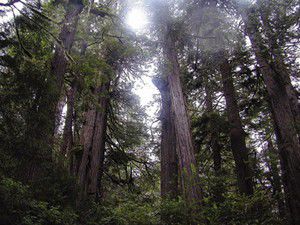Volunteers work to restore long-lost salmon runs on Willapa’s Long Island
Published 4:00 pm Tuesday, December 30, 2003

- The ancient grove of western red cedars on Long Island has survived intact for 800 or more years, protected from fire by the region's wet climate. A political initiative launched by Naselle's Rex Ziak extended national refuge recognition to the grove in the 1980s. As a sort of New Year's Resolution, Volunteer for Wildlife Volunteers recently stocked cutthroat trout and planted salmon eggs in the cedar grove, one of several aquatic and riparian habitats being restored on Willapa National Wildlife Refuge. Below, volunteer Tasha Stenvall hauls a bag of salmon carcasses into the woods, where they will provide nutrients vital to the food chain.
Goal: Naturally spawning fish runs on every stream in wildlife refuge
LONG ISLAND – After lugging burlap sacks weighted with foul-smelling salmon carcasses up and down a slippery make-shift trail alongside Cedar Grove Creek on Long Island, volunteers assisting in fish restoration looked (and smelled) more like creatures from the Hobbit novels than Santa’s jolly helpers.
But a little smell and slime only heightened the spirits of ten volunteers last week as they assisted staff from the Willapa National Wildlife Refuge in stocking cutthroat trout and planting chum salmon eggs into one of America’s most pristine old growth habitats, the famed Cedar Grove on Long Island.
As part of an ongoing restoration program for refuge streams, 65 live cutthroat trout and 50,000 chum salmon eggs donated from state hatcheries were placed in protected pools in the narrow stream winding through the island’s old growth forest. Nearly 1,000 pounds of salmon carcasses were also placed in the stream to provide food and nutrients for the young fish.
“A tidegate placed at the mouth of this stream around 1920 blocked fish from returning here,” noted Charlie Stenvall, project leader for Willapa Wildlife Refuge Complex. “But as you can see, this habitat is ideally suited for these fish. By restoring naturally spawning trout and salmon we encourage other species up and down the food chain, ranging from rare salamanders that thrive here to the birds, bobcats, cougars, otters, bears and other mammals that depend upon this link in their diets.”
Five other streams on the refuge will be studied for fish restoration in 2004.
“Biological assessments of needed restoration activities will be conducted on tributaries to the Bear River and at Quarry Creek,” said Ron Craig, vice president of the Willapa Fisheries Enhancement Group, a non-profit volunteer organization dedicated to salmon recovery. “We’ll look at soil and rock substrates, need for woody debris placement, any blockages or barriers, and of course, water quality. Our strategy is to restore naturally spawning fish runs on every stream in the refuge.”
And this is where volunteers contribute a vital role.
“It takes confident and sure-footed hikers to negotiate a muddy stream bank with an unwieldy load of salmon carcasses and fish eggs,” laughed Bev Arnoldy, president of the Friends of Willapa National Wildlife Refuge, a non-profit volunteer organization directly supporting the mission and activities of the Refuge. “Of course, most of our members support other, less physically-demanding volunteer programs in education, restoration, and wildlife monitoring. The Friends of Willapa invites everyone to join us in continued enhancement of this very special place.”
This year’s volunteer contributions towards habitat restoration commemorate the 100th birthday of the National Wildlife Refuge System, officially created on March 14, 1903 by then-president Theodore Roosevelt. The Willapa Refuge dates from 1937 and now encompasses nearly 16,000 acres with some the richest habitat and variety of wildlife found in any refuge in the country.
“Hundreds of thousands of birds depend on this habitat for rest, nesting and forage, including the endangered western snowy plover,” said Stenvall. “Our year-round residents include over half of all amphibians found in Washington state, including rare salamanders such as Dunn’s, Van Dycke’s and Torrent. And of course, large cats such as cougar and bobcat and raptors such as eagles and falcons share the land with our bear, elk, and deer.”
Ready to add your name to the volunteers who support our refuge? Check out the Friends of Willapa National Wildlife Refuge at (http://www.willapabay.org/~fwnwr/)
or write to the Friends at P.O. Box 1130, Ocean Park, WA 98640. Make an important resolution for 2004 – volunteer for wildlife!









